15 Signs a Stray or Feral Cat Likes You: Understanding Cat Behavior

Updated on
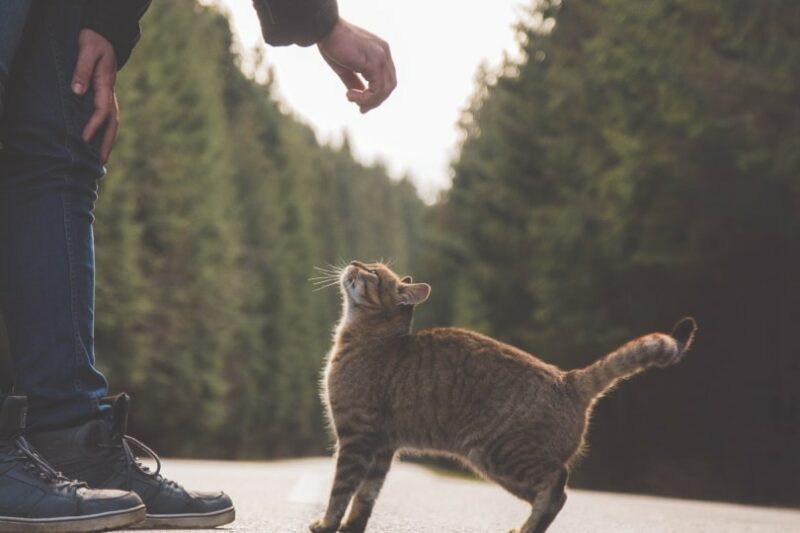
If you’ve ever encountered a stray or feral cat and wondered if it likes you, there are some signs to look out for. Stray and feral cats may not be very affectionate or open to human contact, but they can still show their appreciation in subtle ways. Here are the signs a stray or feral cat likes you.
Stray vs Feral Cat: What’s the Difference?
While some people lump both types of cats together, stray and feral cats are quite different. Stray cats (sometimes called “in-betweeners“) have sometimes been abandoned due to temperament issues or people failing to understand what it takes to care for a cat. These cats still rely on humans for support and can tolerate a degree of human interaction. Strays are usually found living within proximity to people, like hotels, apartment complexes, or farms.
Feral cats, on the other hand, have adapted to free-roaming and free-living. They do not need humans to survive. Some ferals live in a community of other ferals. If left unchecked, this can result in overbreeding. It is extremely difficult (and some say close to impossible) to socialize a feral cat to being a pet. Strays/in-betweeners are easier to socialize because they are used to people and rely on them for resources.
The 12 Signs a Stray or In-Betweener Cat Likes You
1. Eye Contact
Eye contact can be a sign of trust in cats. If a stray cat makes eye contact with you and holds your gaze, this could be a sign that they are comfortable around you and possibly like you.
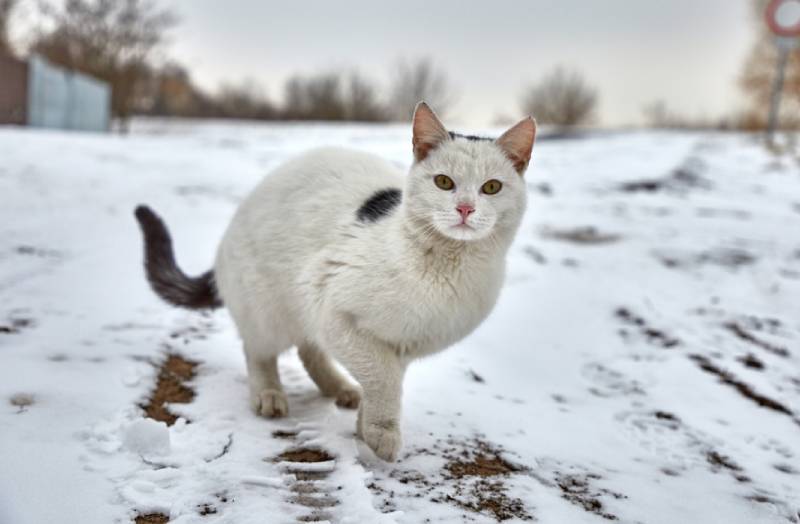
2. Purring
Cats usually purr when they’re content, so if a stray cat is purring while they’re around you, it could be a sign that they trust you and enjoy being near you. However, cats can also use purring to self-soothe themselves when they are nervous, so watch for potential signs of aggression that could indicate that the cat is nervous instead of feeling friendly.
3. Following You Around
If the cat follows you around outside or just seems to always be nearby, this could mean that they like spending time with you and want to stay close. Following you around is another sign of trust in cats.
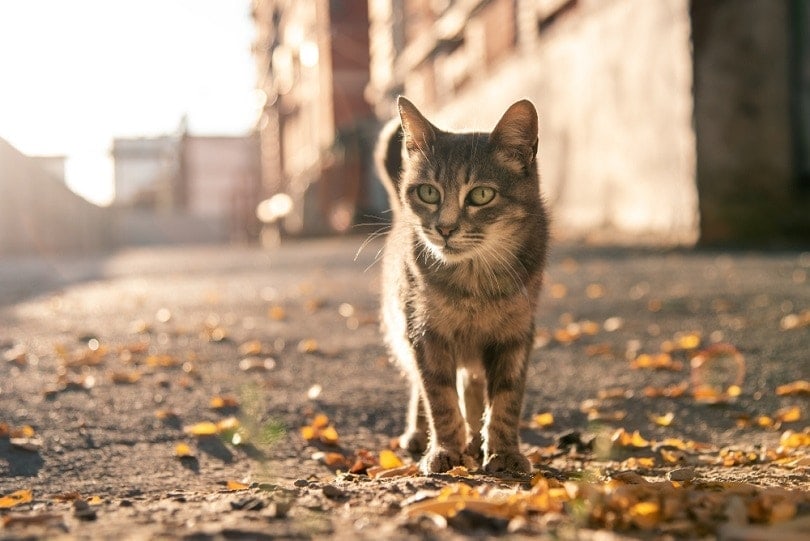
4. Head Bonking
When cats bonk their heads against objects or people, it’s usually a sign of affection. If a stray or in-betweener cat is head-bonking you, it means they like being around you and are comfortable enough to show it.
5. Kneading
Kneading is when cats press their front paws into an object or person while purring in contentment. This behavior usually indicates that the cat feels safe and happy with you and is sometimes referred to as “making biscuits.”

6. Rubbing Against You
Cats often use rubbing as a way to mark people, objects, and territory as belonging to them. If a stray cat is rubbing against your legs or other objects, this could mean that they consider you part of their “territory” and are comfortable with you being there.
7. Tail Up
When cats keep their tail up, it usually means they’re feeling content and confident. If a stray is keeping their tail up while you’re around, this could be a sign that they like you and trust you.
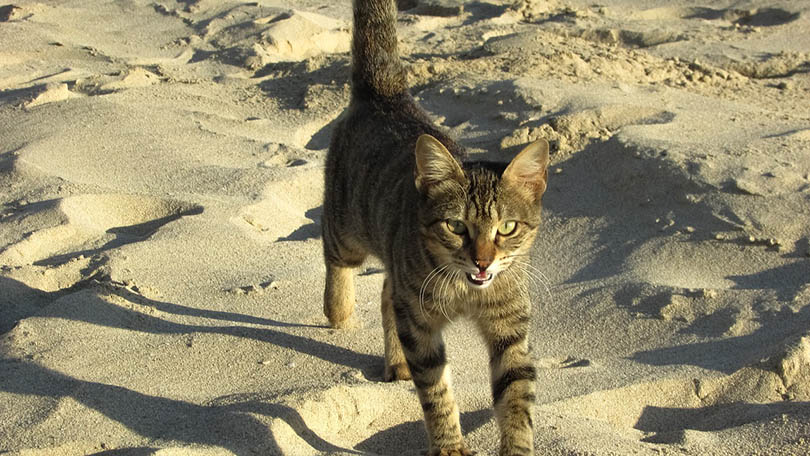
8. Cheek Rubbing
Unlike rubbing their head against something, when cats rub their cheeks against an object or person, it’s usually a sign of love and affection. If a stray cat is cheek rubbing you, it means they trust and like you enough to show physical contact towards you.
9. Rolling Over
Cats will often roll over on their back in an invitation for belly rubs when they are feeling comfortable with you. If a stray cat rolls over while they’re around you, it could mean that they like you and want to interact with you.
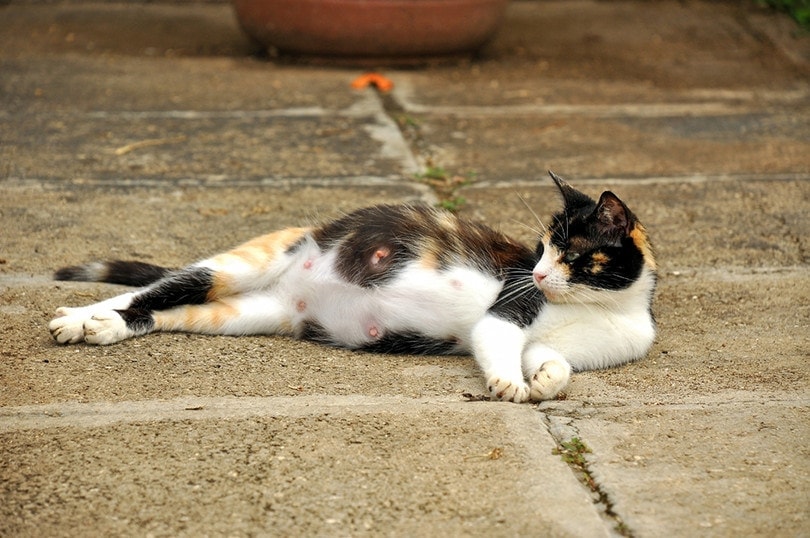
10. Vocalization
Cats will often meow, chirp, or trill when they are feeling content and comfortable with someone. If a stray cat vocalizes when they’re around you, it could be a sign that they appreciate your presence and enjoy being near you.
11. Eating From Your Hand
Giving food is one of the best ways to build trust between humans and cats. So, if a stray cat eats from your hand, it could be a good indication that they like and trust you.
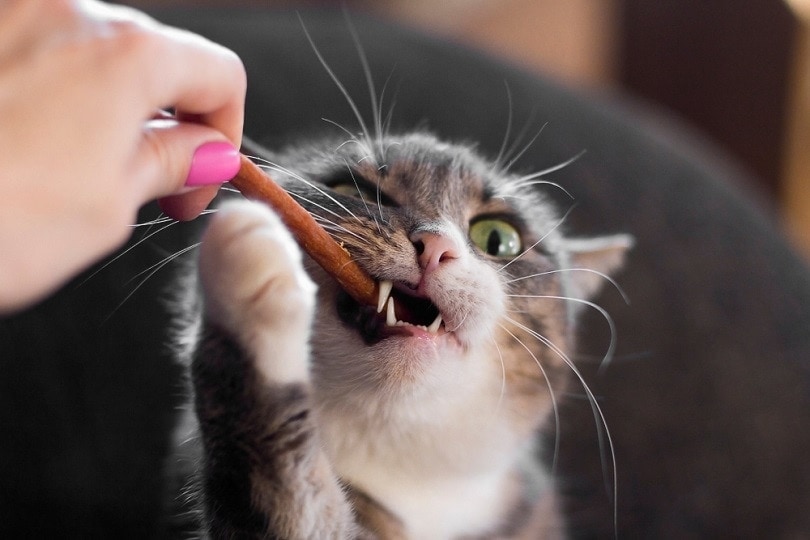
12. Sleeping Near You
Cats typically sleep near people and things they trust. So, if a stray cat sleeps near you, it could be a sign that they feel safe enough to relax in your presence.
The 3 Signs a Feral Cat Trusts You
Unfortunately, a feral cat will probably never like you the way a stray/in-betweener cat will; feral cats have adapted to not need people for survival. However, there are some signs that a feral cat trusts you.
1. Does Not Run Off Immediately
A feral cat will never allow you to get too close to them. However, if they trust or tolerate you, they might linger for a few moments if you are 15 to 20 feet away. Then, they might walk away instead of running. This might show that they do not view you as a threat.
2. Eats the Food You Leave Out
Feral cats have adapted to finding their own food, either through hunting or savaging. If you have ferals living around your area, you might be inclined to leave food out for them. If the feral cat eats the food you leave out, that could be a sign they trust you. If they were entirely fearful of you, they might not go anywhere near the food.
3. Sleeping in Enclosures Left Out for Them
Feral cats are used to finding places to sleep. However, some people make small enclosures for ferals during the winter months. Since animals will sleep where they feel safe, a feral cat using the enclosure you set up for them could be a sign they trust you.
Ways to Help a Cat Like You
Speak Softly and Gently
Cats can sense when we’re speaking in a harsh tone, so using a gentle voice around them will help make them feel more comfortable.
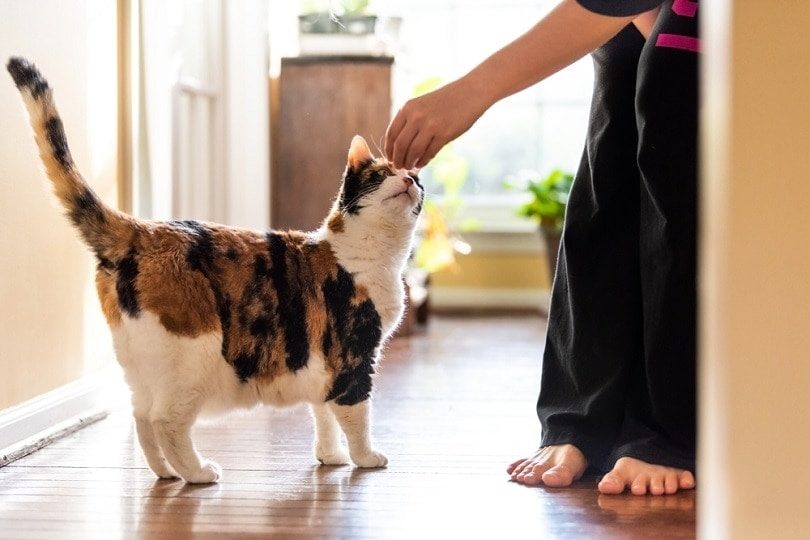
Offer Treats or Food
Offering treats or food is an excellent way to start building trust with your cat. Start small and allow the cat to come to you for their reward rather than trying to hand-feed them.
Use Toys
Playing with your cat is an excellent way to bond because it lets them know that you want to interact with them. Choose toys that mimic prey, such as balls with feathers or strings on the end, as these are usually most appealing for cats.
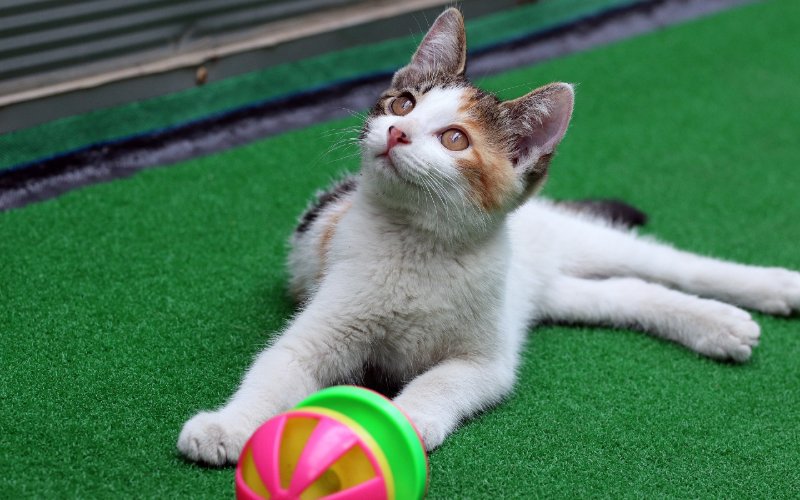
Give Them Space
Cats often need time to adjust to new situations and people, so it’s important to give them the chance to explore their environment at their own pace. Allow them some alone time if they seem overwhelmed or shy.
Avoid Picking Them Up
It can be tempting to scoop up your cat when you see them, but cats don’t always appreciate this behavior, especially if they’re not used to it. Try using a soft blanket or towel instead so that your cat has something between you and them if they want to retreat.
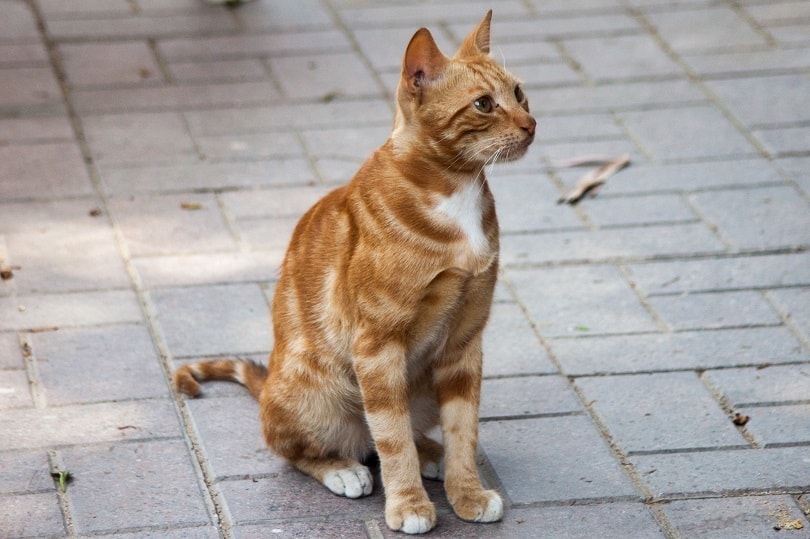
Other Signs a Cat Is Happy
- Head Butting: When cats rub their head against something or someone, it could be a sign of affection or trust.
- Tail Flicking: A cat’s tail will often flick when they are happy and excited to interact with you.
- Relaxed Posture: If your cat is lying down on its back, stretching out its legs, or lying flat on the floor, this is typically an indication of relaxation and comfort.
- Grooming: Cats often groom themselves when they are feeling relaxed and content.
- Meowing: Cats may meow, chirp, or make other noises when they want to communicate with you. This could be a sign that your cat is feeling comfortable around you and wants to interact.
Signs a Cat Is Unhappy
- Hissing/Growling: If your cat hisses or growls at you, it’s usually a sign that they’re feeling threatened or scared.
- Claws Out: When cats have their claws out, it could be an indication that they are feeling defensive or irritated.
- Avoidance: Cats typically avoid situations and people they don’t like, so if your cat is avoiding contact with you, it may be a sign that they don’t feel comfortable around you.
- Excessive Shedding: Stress can cause cats to shed more often than normal, so if you notice increased shedding in your cat, it could be a sign that they’re feeling anxious or stressed.
- Aggression: If your cat is displaying aggressive behavior such as biting, swatting, or lunging, it could be a sign that they are feeling threatened or scared.
- Excessive Vocalization: If your cat is making loud noises or meowing more often than usual, this could be an indication that they’re feeling distressed or unhappy.
- Changes in Appetite/Weight Loss: Stress can cause cats to lose their appetite and lose weight, so if you notice changes in your cat’s eating habits, it may be a sign that something is wrong.

Tips for Handling a Feral or Stray Cat
- Wear Gloves: It’s important to wear gloves when handling a feral or stray cat as they may be carrying diseases or parasites that could be harmful to humans.
- Take It Slow: Try to move slowly and calmly around the cat so you don’t startle them. You can also put down blankets and towels on the ground for them to hide under if they feel scared.
- Give Them Space: Cats need their space, so try not to invade their personal bubble too much until they start to feel more comfortable with you.
- Talk Softly and Offer Treats: Talking softly and offering treats can help build trust between you and the cat, so try doing this whenever possible.
- Visit Your Vet: If you manage to catch the cat, make sure to take it to your vet as soon as possible for a proper check-up.
Managing an Aggressive Cat
- Keep Calm: It’s important not to panic or get angry when handling an aggressive cat, as this could make the situation worse. Instead, remain calm and try to distract the cat with toys or treats if necessary.
- Avoid Eye Contact: Staring directly into a cat’s eyes can be seen as confrontational, so try not to make direct eye contact with them unless absolutely necessary.
- Stay Away from Their Tail: Cats often lash out if their tail is touched, so try to stay away from their tail whenever possible.
- Take Breaks: If your cat is getting too aggressive or agitated, take a break and allow them to calm down before continuing.
- Talk to Your Vet: Speak with your vet if the aggression persists as they may be able to provide additional advice and solutions on how to better manage the situation.
Conclusion
Cats can make wonderful companions, but it’s important to understand the signs of a happy and an unhappy cat, especially when dealing with a feral or stray cat. By understanding a cat’s behavior and respecting their individual preferences and personalities, you may be able to create a strong bond with them and ensure they are content in or around your home!
Featured Image Credit: Vlad Bagacian, Pexels












